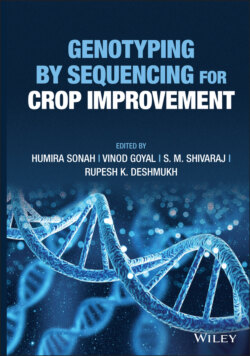Читать книгу Genotyping by Sequencing for Crop Improvement - Группа авторов - Страница 30
1.5.4 Kompetitive Allele‐Specific PCR (KASP™)
ОглавлениеKASP™ is a trademark technology of KBiosciences (http://www.kbioscience.co.uk/) or LGC genomics (http://www.lgcgenomics.com) initially developed for in‐house genotyping, thereafter evolving as a benchmark technology for SNP genotyping. Any candidate SNP identified through GBS or WGR and associated with any important traits can be validated through KASP assay. Furthermore, any identified candidate SNP associated with a trait of interest can be readily converted into KASP assay to serve as a robust and cost‐effective marker to be used as a MAS tool for crop improvement. It works on the principle of competitive allele‐specific PCR permitting bi‐allelic scoring of SNP, insertion, and deletions (InDels) at a specific location in the genome (Figure 1.2). KASP genotyping reaction consists of DNA sample, KASP assay mix, and universal KASP master mix. Allele‐specific two forward primers and common reverse primer all unlabelled constitute KASP assay mix. Allele‐specific primers have a unique tail sequence complementary to FRET (fluorescence resonant energy transfer) cassette. Each allele harbors a tail sequence linked to different dyes (FAM™ and HEX™ dyes). KASP master mix has FRET cassettes in the quenched state, a passive reference dye (ROX™), and other components for PCR reaction. During the first round of reaction allele‐specific primer binds to template incorporating tail sequence in newly synthesized strands. In the next round of PCR, a complementary strand of the allele‐specific tail sequence is generated allowing the FRET cassette to bind enabling an unquenched state, and generating a fluorescent allele‐specific signal. In the case of a homozygous DNA sample, only one signal specific to the allele is seen and mixed signal is generated in the case of the heterozygous individual. It can be carried out in 96‐ to 1536‐well plate format. Application of KASP includes QC (quality control) analysis, QTL mapping, allele mining (Semagn et al. 2013), and MAS. However, it may not be a suitable platform for genome‐wide association mapping and genomic selection due to fewer data points. KASP markers have been utilized extensively for MAS in major crops like rice (Yang et al. 2019; Kang et al. 2019), wheat (Makhoul et al. 2020; Fang et al. 2020; Grewal et al. 2020), and maize (Zhang et al. 2017; Su et al. 2016).
Figure 1.2 Steps in KASP reaction: (a) annealing: allele‐specific primer binds to target SNP, (b) extension: anti tail sequence generation leading to disassembly of allele‐specific FRET cassette, and (c) fluorescent emission: sample emitting fluorescence on exposing to a specific wavelength.
Source: The figure is reproduced from Rosas et al. (2014) available with CC‐BY‐4.0.
